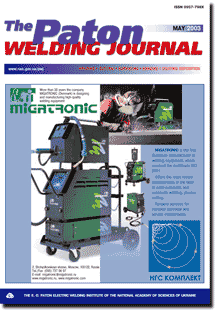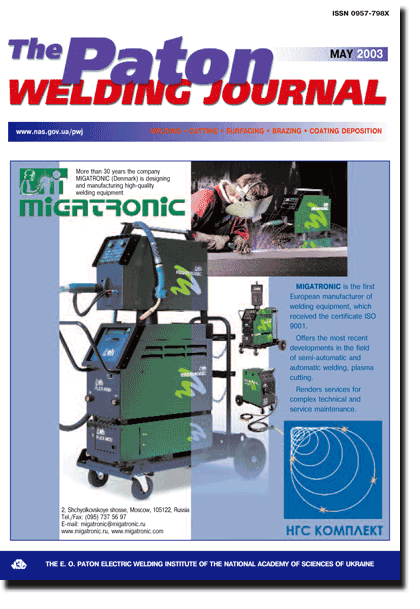

| SCIENTIFIC AND TECHNICAL | |
| Paton B.E., Savitsky M.M., Gvozdetsky V.S., Krivtsun I.V., Savitsky A.M., Godlis Yu.E. and Lupan A.F. Application of active fluxes and active gases to increase efficiency of arc and plasma welding. | 2 |
| Considered are probable causes of increase in the penetration depth in plasma and arc welding by the MIG and TIG methods using activating fluxes. It is shown that deep penetration of metal is caused by contraction of the arc and increase in the concentration of thermal and mechanical effects of plasma on metal with a simultaneous decrease in its surface tension at the presence of elements that have a high surface activity and susceptibility to formation of negative or positive ions. | |
| Slivinsky A.A. and Veit P. Structure and properties of welded joints of nickel-based heat-resistant alloy. | 6 |
| Results of metallographic examinations of different regions of the NiCr25FeAlY high-nickel alloy welded joints, made by tungsten electrode in inert gas, consumable electrode in mixture of gases and under the flux layer, are given. Susceptibility of the alloy to the formation of hot cracks was evaluated and the presence of ductility dip in it near 700 oC temperature after heat treatment was found. The relationship was established between the decreased ductility of the alloy and formation of phase and chemical heterogeneity. | |
| Zadery B.A., Kotenko S.S., Polishchuk E.P., Yushchenko K.A., Barabash O.M. and Karasevskaya O.P. Peculiarities of crystalline structure of welded joints in single crystals. | 13 |
| Crystallographic texture and microstructure of fusion welded joints were studied. Criteria were selected for estimation of the degree of inheritance of structural state of the base metal by the weld metal. Factors determining the degree of such inheritance were established, and conditions for a minimum distortion of the structural state were identified. | |
| Bernatsky A.V. Additional approaches to the evaluation of susceptibility of low-carbon and low-alloy steels to lamellar-tough and lamellar-brittle fractures. | 21 |
| The paper sets forth the possibilities for determination of reduction in area jz and KCVz based on the results of testing standard samples cut out across the direction of rolling on the sheet plane. An additional notion of lamellar cracking coefficient is introduced, which is the KCVzmax: KCVmax ratio in the entire range of transition temperature. | |
| Petushkov V.G. Redistribution of residual welding stresses under the effect of normal incident shock wave. | 25 |
| Interaction of normal incident shock wave with the field of internal stresses in metal is considered. It is shown that under rational conditions of loading of structural steels this correction is about 5 % of the wave amplitude. Therefore, it can be ignored in practical calculations. | |
| Tararychkin I.A. Method of evaluation of the effectiveness of multifactorial control of the welding process. | 28 |
| The paper suggests a method to evaluate the effectiveness of preventive measures, aimed at improvement of the accuracy of the multifactorial process. Criteria are defined, which allow determination of the nature of the change in the accuracy and stability of the process being controlled. The possibilities of the method are considered in the case of narrow-gap arc welding of a circumferential weld on a thick-walled cylindrical shell. | |
| Shlepakov V.N. and Naumejko S.M. Calculation of viscosity of slag systems of flux-cored wires. | 31 |
| Van-Laar theory and Melvin-Hughs methods were the basis to develop the procedure of evaluation of dynamic viscosity of three-component salt-oxide systems. The possibility of preliminary theoretical investigation of the viscosity of slag systems is demonstrated. | |
| INDUSTRIAL | |
| Mikhoduj L.I., Kirian V.I., Poznyakov V.D., Strizhak P.A. and Snisarenko V.V. Sparsely-alloyed high-strength steels for welded structures. | 34 |
| Results of analysis of properties and weldability of sparsely-alloyed high-strength steels of 06G2B and 09G2SYuch (sy“ “440 MPa) are given. Prospects of their use in manufacture of unique and reliable engineering structures of different purpose (bridges, towers, pressure vessels, tanks) are estimated. | |
| Nazarchuk A.T., Snisar V.V. and Demchenko E.L. Producing welded joints equivalent in strength on quenching steels without preheating and heat treatment. | 38 |
| The paper deals with the possibility of producing equivalent joints on high-strength quenching steels by arc welding without preheating and heat treatment. Good prospects for application of austenitic-martensitic consumables in welding of high-strength steels without preheating and heat treatment with the level of weld metal strength of 1150-1200 MPa. | |
| Basov G.G. and Tkachenko A.N. Manufacture of side walls of car bodies with stainless steel panels. | 43 |
| A modular design of side walls of diesel and electric train cars is proposed, as well as specialized fixtures for manufacture of parts and welded components, improving the efficiency and labour conditions. Technological features of welding the module are described. | |
| Belous V.Yu., Zamkov V.N., Petrichenko I.K. and Topolsky V.F. Filler wire for narrow-gap welding of titanium alloy VT23. | 46 |
| Experience of practical application of narrow-gap welding of titanium and titanium alloy structures has been analyzed, and advantages of this new technology are demonstrated. Good prospects for application of magnetic processes of welding arc control is noted. | |
| BRIEF INFORMATION | |
| Demidenko L.Yu., Onatskaya N.A. and Yurchenko E.S. Thermal-pressure joining of tubes to tube sheets of high-alloy steels by the electro-hydropulse welding method. | 49 |
| The quality of joints between tubes and tube sheets made by the thermal-pressure electro-hydropulse process has been estimated from the results of strength tests and metallographic examinations. It is shown that in compact heat exchangers of high-alloy steels a metal bond is formed on an area of more than 50 % of the entire mating surfaces. | |
| But V.S. and Maksimov S.Yu. Influence of hydrostatic pressure in underwater wet welding on the properties of welded joints. | 51 |
| Wet underwater welding is performed directly in the water. In this case, the electrode, arc and item are not protected from the impact of the environment, which influences both the nature of running of the metallurgical processes and formation of the structure of welded joint metal. | |
| Multipurpose power source for consumable electrode arc methods of welding. | 53 |
(You are viewing the simplified file contents)
The cost of subscription/purchase order journals or individual articles
| Journal/Currency | Annual Set | 1 issue printed |
1 issue |
one article |
| TPWJ/USD | 384 $ | 32 $ | 26 $ | 13 $ |
| TPWJ/EUR | 348 € | 29 € | 24 € | 12 € |
| TPWJ/UAH | 7200 UAH | 600 UAH | 600 UAH | 280 UAH |
| AS/UAH | 1800 UAH | 300 UAH | 300 UAH | 150 UAH |
| AS/USD | 192 $ | 32 $ | 26 $ | 13 $ |
| AS/EUR | 180 € | 30 € | 25 € | 12 € |
| SEM/UAH | 1200 UAH | 300 UAH | 300 UAH | 150 UAH |
| SEM/USD | 128 $ | 32 $ | 26 $ | 13 $ |
| SEM/EUR | 120 € | 30 € | 25 € | 12 € |
| TDNK/UAH | 1200 UAH | 300 UAH | 300 UAH | 150 UAH |
| TDNK/USD | 128 $ | 32 $ | 26 $ | 13 $ |
| TDNK/EUR | 120 € | 30 € | 25 € | 15 € |
AS = «Automatic Welding» - 6 issues per year;
TPWJ = «PATON WELDING JOURNAL» - 12 issues per year;
SEM = «Electrometallurgy Today» - 4 issues per year;
TDNK = «Technical Diagnostics and Non-Destructive Testing» - 4 issues per year.


